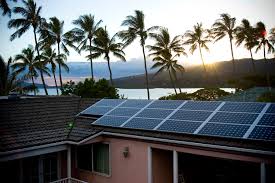While doing a recent article, I came across FAQs by MNRE regarding Grid Connected Solar Rooftop Systems. I found them very helpful and wanted to share with my readers, in case you haven’t come across this one. The list is by no means exhaustive but attempts at answering most of the common questions that spring in our minds. Here is the list from MNRE:
1. What is a Solar Rooftop System?
In a solar rooftop system, the solar panels are installed in the roof of any residential, commercial, institutional and industrial buildings. This can be of two types (i) Solar Rooftop System with storage facility using a battery, and (ii) Grid Connected Solar Rooftop System.
2. What is a Solar Rooftop System with Storage facility?
Solar rooftop system has a battery as the storage facility. The solar electricity is stored in the battery and can be utilized during the night also when the sun is not available.
Also, read What returns can I get from a Rooftop Solar System in India
3. What is a Grid Connected Solar Rooftop System?
In grid-connected rooftop or small SPV system, the DC power generated from SPV panel is converted to AC power using power conditioning unit and is fed to the grid either of 33 kV/11 kV three phase lines or of 440/220 Volt three/single phase line depending on the capacity of the system installed at institution/commercial establishment or residential complex and the regulatory framework specified for respective States.
These systems generate power during the daytime which is utilized fully by powering captive loads and feed excess power to the grid as long as the grid is available. In case, where solar power is not sufficient due to cloud cover etc., the captive loads are served by drawing power from the grid.
4. Where such plants can be installed?
Such rooftop systems can be installed at the roofs of residential and commercial complex, housing societies, community centers, government organizations, private institutions etc.
5. What is the average cost of grid-connected rooftop solar systems?
The average cost of grid-connected rooftop solar systems is about Rs. 80 per watt or Rs. 8.0crore per MWp capacity.
6. What is the Financial Assistance provided by the Ministry?
There is a provision of Central Financial Assistance of 15% of the total cost or Rs. 12 per watt or Rs. 1.20 crore per MWp under the Grid Connected Rooftop and Small Solar Plants Programme of the Ministry. This CFA has been reduced from 30% to 15%.
7. What are the other fiscal incentives are available for Solar Rooftop Systems?
There are provisions of concessional import duty/excise duty exemption, accelerated depreciation, and tax holiday for setting up of grid-connected rooftop power plants.
8. What efforts Government is making to provide loans for solar rooftop systems?
Department of Financial services has instructed to all Public Sector Banks to encourage home loan/ home improvement loan seekers to install rooftop solar PV plants and include the cost of system in their home loan proposals. So far, nine PSBs namely Bank of India, Syndicate Bank, State Bank of India, Dena Bank , Central Bank of India, Punjab National Bank, Allahabad Bank, Indian Bank and Indian Overseas Bank have given instructions to extend loans for Grid Interactive Rooftop Solar PV Plants as a home loan/ home improvement loan.
9. What is the size of a grid-connected rooftop solar system?
The rooftop solar systems from 1 kWp up to 500 kWp or in combination can be set up on the roofs.
10. How much roof area is required to set up the grid-connected rooftop solar system?
About 10sq.m area is required to set up 1 kWp grid-connected rooftop solar system.
11. What are the advantages of Grid-Connected Rooftop Solar System?
- Electricity generation at the consumption center and hence Savings in transmission and distribution losses
- Low gestation time
- No requirement of additional land
- Improvement of tail-end grid voltages and reduction in system congestion with higher self-consumption of solar electricity
- Local employment generation
12. What is the potential available in India?
According to a study conducted by TERI, a potential of 124 GWp SPV Rooftop plants has been estimated in the country. This can be achieved through active support from the States.
13. What is Net metering?
The grid-connected rooftop system can work on a net metering basis wherein the beneficiary pays to the utility on net meter reading basis only. Alternatively, two meters can also be installed to major the export and import of power separately. The mechanism based on gross metering at mutually agreed tariff can also be adopted.
14. What is Feed-in-Tariff?
In feed-in-tariff, the Government offers a tariff for purchase of the solar power generated from such plants.
15. Among net metering and feed-in-tariff, what is preferred?
The net metering mechanism is more popular among States.
16. In the case of grid failure, is there any chance for shocks to the person who is repairing?
In case the grid fails, the solar power has to be fully utilized or stopped immediately feeding to the grid so as to safeguard any grid person/technician from getting shocked (electrocuted) while working on the grid for maintenance etc. This feature is termed as ‘Islanding Protection’.
I have only listed a few questions which I found would be helpful for the readers. If anyone requires more details, please click here.
Google+


